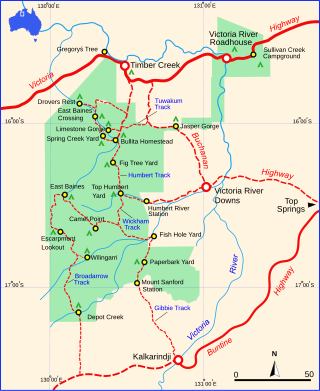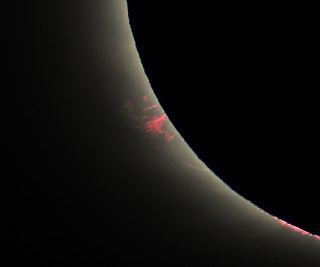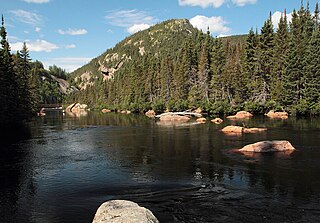
Judbarra National Park, formerly Gregory National Park and Judbarra / Gregory National Park, is a national park in the Northern Territory of Australia, 359 km (223 mi) south of Darwin.
An HTML element is a type of HTML document component, one of several types of HTML nodes. The first used version of HTML was written by Tim Berners-Lee in 1993 and there have since been many versions of HTML. The current de facto standard is governed by the industry group WHATWG and is known as the HTML Living Standard.

In solar physics, a prominence, sometimes referred to as a filament, is a large plasma and magnetic field structure extending outward from the Sun's surface, often in a loop shape. Prominences are anchored to the Sun's surface in the much brighter photosphere, and extend outwards into the solar corona. While the corona consists of extremely hot plasma, prominences contain much cooler plasma, similar in composition to that of the chromosphere.

Iodine-131 is an important radioisotope of iodine discovered by Glenn Seaborg and John Livingood in 1938 at the University of California, Berkeley. It has a radioactive decay half-life of about eight days. It is associated with nuclear energy, medical diagnostic and treatment procedures, and natural gas production. It also plays a major role as a radioactive isotope present in nuclear fission products, and was a significant contributor to the health hazards from open-air atomic bomb testing in the 1950s, and from the Chernobyl disaster, as well as being a large fraction of the contamination hazard in the first weeks in the Fukushima nuclear crisis. This is because 131I is a major fission product of uranium and plutonium, comprising nearly 3% of the total products of fission. See fission product yield for a comparison with other radioactive fission products. 131I is also a major fission product of uranium-233, produced from thorium.

A film poster is a poster used to promote and advertise a film primarily to persuade paying customers into a theater to see it. Studios often print several posters that vary in size and content for various domestic and international markets. They normally contain an image with text. Today's posters often feature printed likenesses of the main actors. Prior to the 1980s, illustrations instead of photos were far more common. The text on film posters usually contains the film title in large lettering and often the names of the main actors. It may also include a tagline, the name of the director, names of characters, the release date, and other pertinent details to inform prospective viewers about the film.

Far Horizons: All New Tales from the Greatest Worlds of Science Fiction is an anthology of original science fiction stories edited by Robert Silverberg, first published in hardcover by Avon Eos in May 1999, with a book club edition following from Avon and the Science Fiction Book Club in July of the same year. Paperback and trade paperback editions were issued by Eos/HarperCollins in May 2000 and December 2005, respectively, and an ebook edition by HarperCollins e-books in March 2009. The first British edition was issued in hardcover and trade paperback by Orbit/Little Brown in June 1999, with a paperback edition following from Orbit in July 2000.
Iodine-123 (123I) is a radioactive isotope of iodine used in nuclear medicine imaging, including single-photon emission computed tomography (SPECT) or SPECT/CT exams. The isotope's half-life is 13.2230 hours; the decay by electron capture to tellurium-123 emits gamma radiation with a predominant energy of 159 keV. In medical applications, the radiation is detected by a gamma camera. The isotope is typically applied as iodide-123, the anionic form.

In enzymology, a riboflavin kinase is an enzyme that catalyzes the chemical reaction

An intentionally blank page is a page that has no content and may be unexpected. Such pages may serve purposes ranging from place-holding to space-filling and content separation. Sometimes, these pages carry a notice such as "This page was intentionally left blank." Such notices typically appear in printed works, such as legal documents, manuals, and exam papers, in which the reader might otherwise suspect that the blank pages are due to a printing error and where missing pages might have serious consequences.

Tucker bag is a traditional Australian term for a storage bag used by travellers in the outback, typically a swagman or bushman, for carrying subsistence food. In its basic design a tucker bag is a pouch or bag with a single entry typically closed with a drawstring, and may have been made of leather or oilskin.

"That's Someone You Never Forget" is a song co-written by Elvis Presley in 1961 and published by Elvis Presley Music, which appeared as the closing track on his 1962 album Pot Luck and was released as a single in 1967.

A bergère hat is a flat-brimmed straw hat with a shallow crown, usually trimmed with ribbon and flowers. It could be worn in various ways with the brim folded back or turned up or down at whim. It is also sometimes called a milkmaid hat. It was widely worn in the mid-18th century, and versions may be seen in many British and French paintings of the period, such as The Swing by Fragonard, and in portraits by Thomas Gainsborough and Johann Zoffany, amongst others. It has been suggested that the hat was named after Madame Bergeret, who is holding a shepherdess-style hat in a Boucher portrait painted c.1766.

Lq2 is a component of the venom of the scorpion Leiurus quinquestriatus. It blocks various potassium channels, among others the inward-rectifier potassium ion channel ROMK1.

The Devonian Foreknobs Formation is a mapped bedrock unit in Pennsylvania, Maryland, Virginia, and West Virginia.
Papyrus Oxyrhynchus 71 contains two petitions with a fragment of a third, addressed to the praefect and written in Greek. The manuscript was written on papyrus in the form of a sheet. It was discovered by Grenfell and Hunt in 1897 in Oxyrhynchus. The document was written on 28 February 303. Currently it is housed in the British Museum (755) in London. The text was published by Grenfell and Hunt in 1898.
Papyrus Oxyrhynchus 131 is a letter concerning a disputed inheritance, written in Greek and discovered in Oxyrhynchus. The manuscript was written on papyrus in the form of a sheet. The document was written in the 6th or 7th century. Currently it is housed in the Egyptian Museum (10063) in Cairo.
Papyrus Oxyrhynchus 132 is a memorandum concerning the division of a bequest, written in Greek and discovered in Oxyrhynchus. The manuscript was written on papyrus in the form of a sheet. The document was written in the late 6th or early 7th century. Currently it is housed in the Egyptian Museum (10133) in Cairo.
Acropora batunai is a species of acroporid coral that was described by Carden Wallace in 1997. Found in protected, shallow reefs, it occurs in a marine environment at depths of up to 44 m (144 ft). The species is rated as vulnerable on the IUCN Red List, with a decreasing population, and is extremely fragile. It can be found over a large area but, overall, is not common.

The Port-Cartier-Sept-Îles Wildlife Reserve is a wildlife reserve in the province of Quebec, Canada.
Mandaic lead rolls, sometimes also known as Mandaic amulets or sheets, which are related to Palestinian and Syrian metal amulets, are a specific term for a writing medium containing incantations in the Mandaic script incised onto lead sheets with a pin. Some Mandaic incantations are found on gold and silver sheets. They are rolled up and then inserted into a metal capsule with loops on it to be worn around the neck on a string or necklace.













